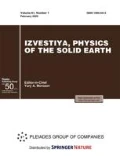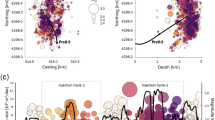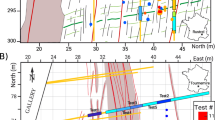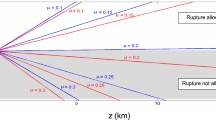Abstract
Man-made seismicity is a response of the brittle crust to fluid injection at depth and to the subsequent increase in pore-pressure and stress field perturbations. In Oklahoma, where the sharp increase in earthquake rate correlates with injection operations, we show that the earthquake-size distribution can differ significantly on the volume of injected fluid. The size distribution of M < 3.5 earthquakes exhibits a near-constant slope b, while significant variation of b-values (from b ≈ 1 to b > 2) may be documented for larger magnitude ranges. This change shows statistically significant positive dependence on injection activity. In addition, largest events occur at the border of the injection area at some distance from massive injection, and in the periods of steady injection rate. These observations suggest that a deficit of large induced earthquakes under conditions of high injection rate can be accompanied by an overall increase of natural seismicity along pre-existing faults in the surrounding volume, where large events are more likely to be triggered over longer space-time scales.





Similar content being viewed by others
REFERENCES
Adushkin, V.V. and Turuntaev, S.B., Tekhnogennaya seismichnost’–indutsirovannaya i triggernaya (Man-Made Seismicity: Induced and Triggered), Moscow: IDG RAN, 2015.
Barbour, A., Norbeck, J.H., and Rubinstein, J.L., The effects of varying injection rates in Osage county, Oklahoma, on the 2016 Mw 5.8 Pawnee earthquake, Seismol. Res. Lett., 2017, vol. 88, no. 4, pp. 1040–1053. https://doi.org/10.1785/0220170003
Bender, B., Maximum likelihood estimation of b-values for magnitude grouped data, Bull. Seismol. Soc. Am., 1983, vol. 73, no. 3, pp. 831–851.
Chen, X., Nakata, N., Pennington, C., Haffener, J., Chang, J.C., He, X., Zhan, Z., Ni, S. and Walter, J.I., The Pawnee earthquake as a result of the interplay among injection, faults and foreshocks, Sci. Rep., 2017, vol. 7, paper ID 4945. https://doi.org/10.1038/s41598-017-04992-z
Cornet, F., Seismic and aseismic motions generated by large scale fluid injections in a deep granite massif, Proc. 47th US Rock Mechanics/Geomechanics Symposium, San Francisco, 2013, New York: Curran Associates, 2013, vol. 2, pp. 987–994.
Davis, S.D. and Frohlich, C., Did (or will) fluid injection cause earthquakes?-criteria for a rational assessment, Seismol. Res. Lett., 1993, vol. 64, nos. 3–4, pp. 207–224.
Dinske, C. and Shapiro, S.A., Seismotectonic state of reservoirs inferred from magnitude distributions of fluid-induced seismicity, J. Seismol., 2013, vol. 17, no. 1, pp. 13–25. https://doi.org/10.1007/s10950-012-9292-9
Ellsworth, L.E., Injection-induced earthquakes, Science, 2013, vol. 341, no. 6142, pp. 1225,942-1–1225,942-7. https://doi.org/10.1126/science.1225942
Ellsworth, W.L., Llenos, A.L., McGarr, A.F., Michael, A.J., Rubinstein, J.L., Mueller, C.S., Petersen, M.D., and Ca-lais, E., Increasing seismicity in the U.S. midcontinent: Implications for earthquake hazard, Leading Edge, 2015, vol. 34, no. 6, pp. 618–626.
Grandin, R., Vallée, M., and Lacassin, R., Rupture process of the Mw 5.7 Pawnee, Oklahoma, earthquake from Sentinel-1 InSAR and seismological data, Seismol. Res. Lett., 2017, vol. 88, no. 3, pp. 1–11.
Heimpel, M. and Malin, P., Aseismic slip in earthquake nucleation and self-similarity: evidence from Parkfield, California, Earth Planet. Sci. Lett., 1998, vol. 157, no. 3, pp. 249–254.
Hincks, T., Aspinall, W., Cooke, R., and Gernon, T., Oklahoma’s induced seismicity strongly linked to wastewater injection depth, Science, 2018, vol. 359, no. 6381, pp. 1251–1255. https://doi.org/10.1126/science.aap7911
Hong, Z., Moreno, H.A., and Hong, Y., Spatiotemporal assessment of induced seismicity in Oklahoma: Foreseeable fewer earthquakes for sustainable oil and gas extraction?, Geosciences, 2018, vol. 8, no. 436, pp. 1–15. https://doi.org/10.3390/geosciences8120436
Johann, L., Shapiro, S.A., and Dinske, C., The surge of earthquakes in Central Oklahoma has features of reservoir-induced seismicity, Sci. Rep., 2018, vol. 8, no. 1, paper ID 11505. https://doi.org/10.1038/s41598-018-29883-9
Langenbruch, C., Weingarten, M., and Zoback, M.D., Physics-based forecasting of man-made earthquake hazards in Oklahoma and Kansas, Nat. Commun., 2018, vol. 9, no. 1, Paper ID 3946. https://doi.org/10.1038/s41467-018-06167-4
Marzocchi, W. and Sandri, L., A review and new insights on the estimation of the b-value and its uncertainty, Ann. Geophys., 2003, vol. 46, no. 6, pp. 1271–1282. https://doi.org/10.4401/ag-3472
Narteau, C., Byrdina, S., Shebalin, P., and Schorlemmer, D., Common dependence on stress for the two fundamental laws of statitical seismology, Nature, 2009, vol. 462, no. 3, pp. 642–645. https://doi.org/10.1038/nature08553
Rivière, J., Lv, Z., Johnson, P., and Marone, C., Evolution of b-value during the seismic cycle: Insights from laboratory experiments on simulated faults, Earth Planet. Sci. Lett., 2018, vol. 482, no. 7, pp. 407–413.
Romanowicz, B., Strike-slip earthquakes on quasi-vertical transcurrent faults: Inferences for general scaling relations, Geophys. Res. Lett., 1992, vol. 19, no. 5, pp. 481–484. https://doi.org/10.1029/92GL00265
Rubinstein, J.L., and Mahani, A.B., Myths and facts on wastewater injection, hydraulic fracturing, enhanced oil recovery, and induced seismicity, Seismol. Res. Lett., 2015, vol. 86, no. 4, pp. 1060–1067. https://doi.org/10.1785/0220150067
Schoenball, M., and Ellsworth, W.L., A systematic assessment of the spatiotemporal evolution of fault activation through induced seismicity in Oklahoma and southern Kansas, J. Geophys. Res., 2017a, vol. 122, no. 12, pp. 10189–10206. https://doi.org/10.1002/2017JB014850
Schoenball, M. and Ellsworth, W.L., Waveform-relocated earthquake catalog for Oklahoma and southern Kansas illuminates the regional fault network, Seismol. Res. Lett., 2017b, vol. 88, no. 5, pp. 1252–1258.
Scholz, C., Aviles, C., and Wesnousky, S., Scaling differences between large intraplate and interplate earthquakes, Bull. Seismol. Soc. Am., 1986, vol. 76, no. 1, pp. 65–70.
Schorlemmer, D., Wiemer, S., and Wyss, M., Variations in earthquake-size distribution across different stress regimes, Nature, 2005, vol. 437, no. 7058, pp. 539–542.
Shapiro, S.A., Krüeger, O.S., Dinske, C., and Langenbruch, C., Magnitudes of induced earthquakes and geometric scales of fluid-stimulated rock volumes, Geophysics, 2011, vol. 76, no. 6, pp. WC55–WC63. https://doi.org/10.1190/GEO2010-0349.1
Shapiro, S.A., Krueger, O.S., and Dinske, C., Probability of inducing given-magnitude earthquakes by perturbing finite volumes of rocks, J. Geophys. Res.: Solid Earth., 2013, vol. 118, no. 7, pp. 3557–3575.
Tormann, T., Wiemer, S., and Mignan, A., Systematic survey of high-resolution b-value imaging along Californian faults: inference on asperities, J. Geophys. Res.: Solid Earth, 2014, vol. 119, no. 3, pp. 2029–2054. https://doi.org/10.1002/2013JB010867
Vorobieva, I., Narteau, C., Shebalin, P., Beauducel, F., Nercessian, A., Clourad, V., and Bouin, M.-P., Multiscale mapping of completeness magnitude of earthquake catalogs, Bull. Seismol. Soc. Am., 2013, vol. 103, no. 4, pp. 2188–2202. https://doi.org/10.1785/0120120132
Vorobieva, I., Shebalin, P., and Narteau, C., Break of slope in earthquake size distribution and creep rate along the San Andreas Fault system, Geophys. Res. Lett., 2016, vol. 43, no. 13, pp. 6869–6875. https://doi.org/10.1002/2016GL069636
Vorobieva I.A., Soloviev, A.A., and Shebalin, P.N., Mapping of interplate coupling in the Kamchatka subduction zone from variations in the earthquake size distribution, Dokl. Earth Sci., 2019, vol. 484, no. 4, pp. 478–481. https://doi.org/10.31857/S0869-56524844478-481
Walsh, F.R. III and Zoback, M., Oklahoma’s recent earthquakes and saltwater disposal, Sci. Adv., 2015, vol. 1, no. 5, Paper ID e1500195. https://doi.org/10.1126/sciadv.1500195
Wyss, M., Sammis, C., Nadeau, R., and Wiemer, S., Fractal dimension and b-value on creeping and locked patches of the San-Andreas fault near Parkfield, California, Bull. Seismol. Soc. Am., 2004, vol. 94, no. 2, pp. 410–421.
Author information
Authors and Affiliations
Corresponding authors
Ethics declarations
The method of the study was developed with support of the Russian Federation Ministry of Science and Education (project no. 14.W03.31.0033) and the data analysis under state contract within the research project no. AAAA-A19-119011490127-6.
Rights and permissions
About this article
Cite this article
Vorobieva, I., Shebalin, P. & Narteau, C. Condition of Occurrence of Large Man-Made Earthquakes in the Zone of Oil Production, Oklahoma. Izv., Phys. Solid Earth 56, 911–919 (2020). https://doi.org/10.1134/S1069351320060130
Received:
Revised:
Accepted:
Published:
Issue Date:
DOI: https://doi.org/10.1134/S1069351320060130




